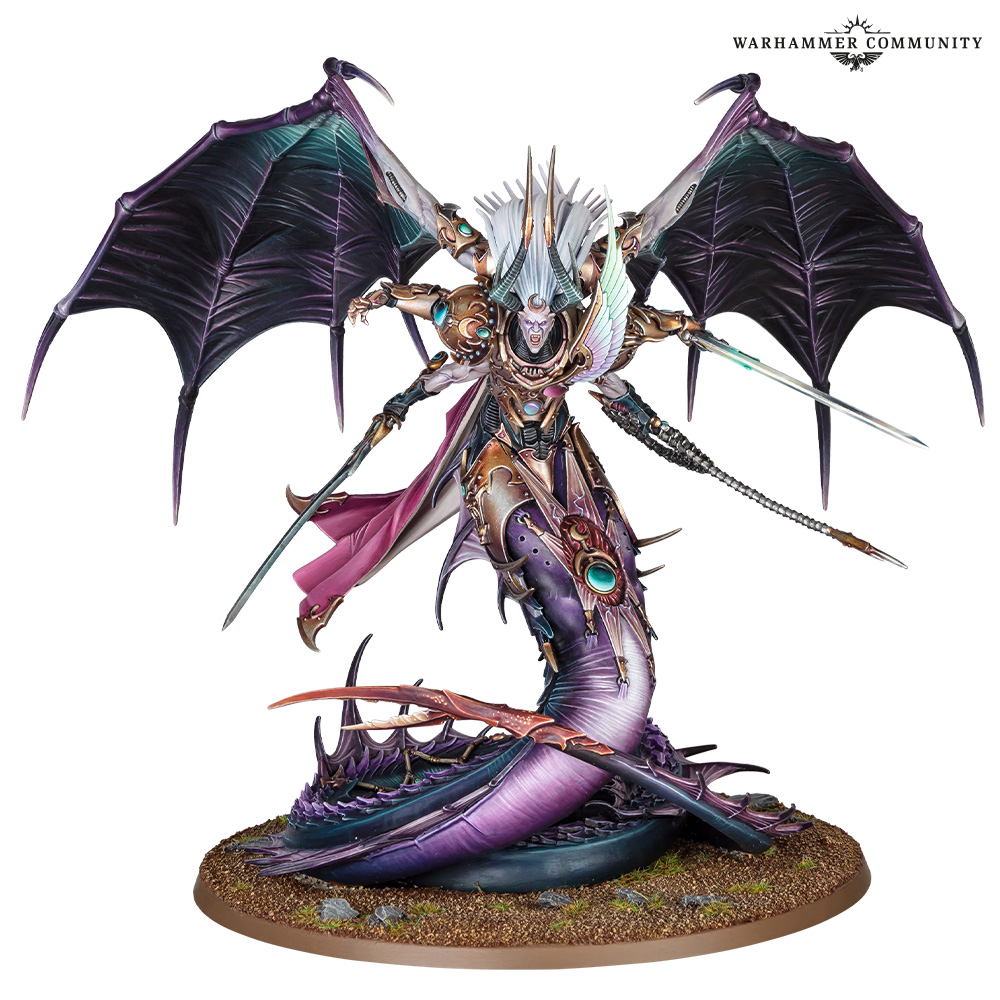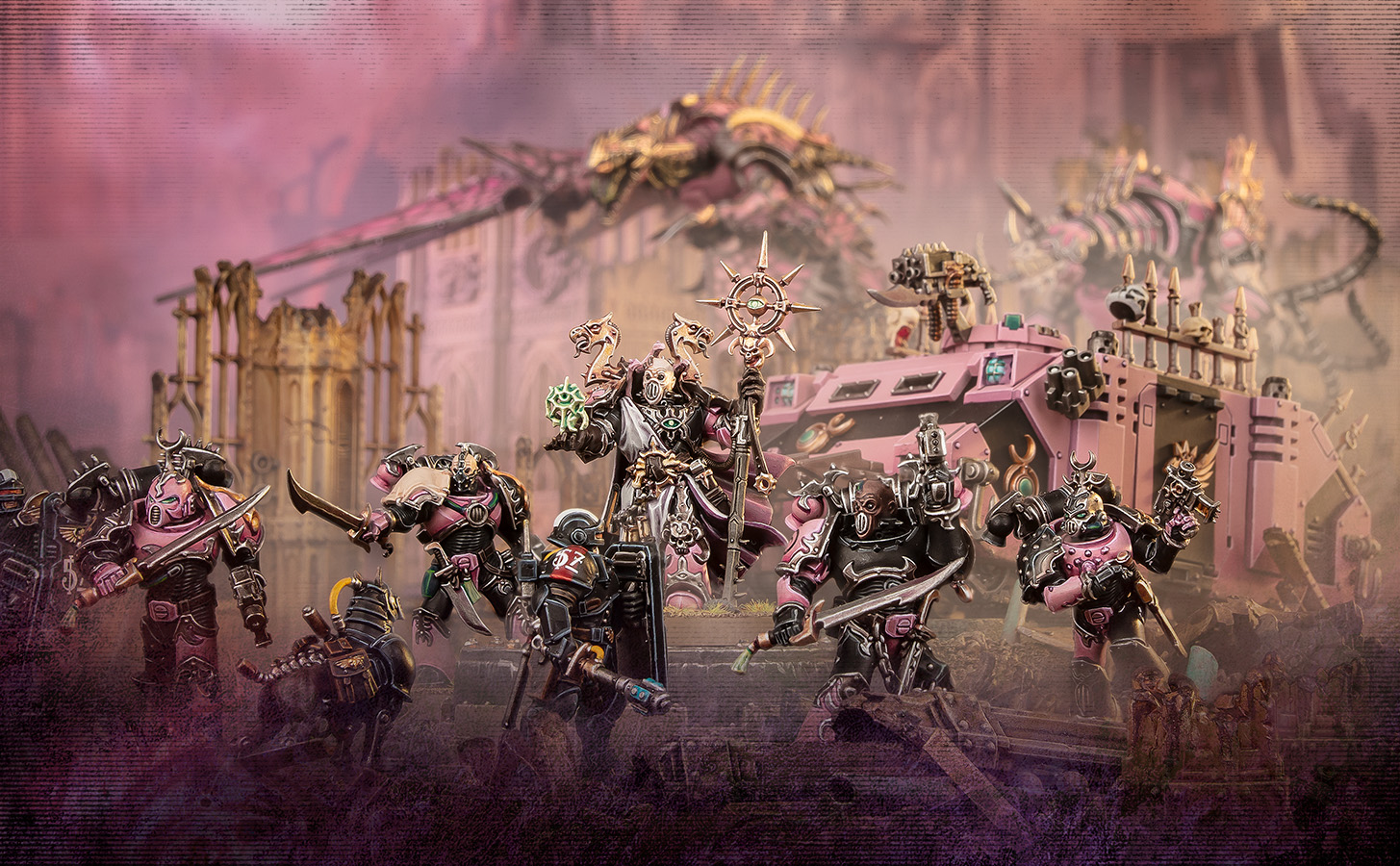The Primarch of the Emperor’s Children is a paragon of depravity and excess. He murdered one of his closest brothers in an act of grand betrayal, and led his Legion into the embrace of the Ruinous Powers in an act of grand hubris. In recent times, he’s been off doing his thing in the Warp – but he’s making his grand return to realspace, and the galaxy just… cannot even. So we spoke to the Warhammer Design Studio to find out how they remade a character whose only previous miniature came out in epic scale during the early 90s!

WarCom: With such high expectations to live up to, not least because Fulgrim equals perfection. How did you approach this monster of a miniature?
David: There was a unique pressure with Fulgrim, as he was the last of the “big four” – and the sixth overall Primarch – designed for Warhammer 40,000.
We wanted to create a vision of the Primarch 10,000 years after the Horus Heresy – and Fulgrim has spent a lot of that time in the Warp.
No matter your strength of character or transhuman physiology, exposure to the Empyrean for that long is going to change you. Because of that, the miniature had to convey a sense of what Fulgrim used to be and also what he has become. He definitely believes he is still beautiful and handsome, but he is ultimately a creature twisted by the Warp.
One idea that hooked me early on was that despite his monstrousness Fulgrim would appear beguiling on the battlefield, and so I arrived at the classic imagery of the mermaid or siren. From a distance he looks appealing and enticing, but up close he is repulsive and deadly.
From there, I moved away from more obviously serpentine design ideas to smoother aquatic elements, creating a godly leviathan. The tail is reminiscent of an eel’s body, there are fins with some piscean feeling, and of course the classic Slaanesh crab claw ties him even further to this oceanic theme.
There were other key elements that needed to be included: he had to have four arms, a sinuous body, and large wings. We also wanted to very strongly keep the telltale signs of his origin as both a Primarch and a Space Marine, so elements such as recognisable power armour and the backpack needed to remain intact.
WarCom: Were there any specific images of Fulgrim that you had in mind while designing him, or any pieces of art that really resonated?

David: While there have been images of Fulgrim’s daemonic form present for many years – and even one very old, very small miniature – the piece of art that resonated most with me was the cover of his Primarch novel. I referenced some of the angular shapes on the armour, and wanted to keep intact the two faces present on the knees. His armour will of course have warped to accommodate his new form over his many years in the Warp, shifting to become hip panels with lurid daemonic faces.

I really like how simple and elegant the armour is, not overly covered in filigree and detail – with that in mind, some of the cloth and armour panels are deliberately flatter to keep the composition balanced and approachable for painters of all levels.
WarCom: Can you talk a bit more about adapting the Gilded Panoply and his unique arsenal of wargear?

David: As a master duellist, we decided Fulgrim would have no bolter of any kind, but we still wanted a way for him to have a presence beyond melee range so landed on a whip to ensnare people and bring them closer. Reading the Horus Heresy books I knew Fulgrim had to have the Fireblade, or perhaps a simulacrum. It was made by his brother Ferrus Manus, and it is supposed to be the perfect blade, so it would make sense that Fulgrim would want to wield it.
It might initially look too clean and too straight for a weapon wielded by the ultimate champion of Slaanesh, but this makes it stand apart. Much like the winged symbol of the Emperor on his shoulder, it remains untouched by the Warp. The other sword is curved and twisted, a dark mirror to the Fireblade – together they represent the duality of Fulgrim, the clash within that tormented him as he succumbed to Chaos.
The layered armour and cloth are designed to convey the excess inherent in the Emperor’s Children, but I wanted Fulgrim to feel from head to tail like a living weapon. Every element is sharp and designed to be wielded against the enemy – if you foolishly tried to grapple this leviathan you’d end up torn to pieces.
WarCom: Such a large and intricate miniature must be a challenge of posing and composition. Where do you start with something so three-dimensional?

David: I initially tried some more arrogant, passive poses for Fulgrim but ultimately he’s a Daemon Primarch and an unparalleled combatant, and so he has to look like a massive threat. I kept the serpentine vibe alive by evoking a cobra rearing to strike, his wings flared back to intimidate and overwhelm. While sculpting this pose I positioned Lion El’Jonson as his opponent – this little face-off between characters helped create context.
I wanted to avoid perfect symmetry in the overall composition. Fulgrim believes he is perfection embodied, but he is a corrupted being so I wanted a lot of things that were mirrored but not identically weighted. The swords are angled for balance but not in the same hands, the whip is mirrored by the fabric on the other side. The overall profile is an S-shape, another nod to Slaanesh – I really tried to consider every single angle.
WarCom: How did the choice of faces come about?

David: The first face I designed for Fulgrim was one of the smiling faces, and while I was sculpting the rest of the miniature it was constantly in my periphery, and it inspired me to add more. I felt it important not to make one handsome, one daemonic, and so on, and so instead they’re all the same face with different expressions for each person to choose from. I also designed a helmet, which has the benefit of being simpler to paint for people who find faces daunting! It also helps to reinforce that idea that the genesis of Fulgrim is still Space Marine – it’s a very classic and subtle design like his armour.
The heads are designed to be painted separately and glued on afterwards. It’s worth noting that the arms and torso can also be painted separately – while the wings and backpack can be left off from the torso for ease.
WarCom: Were there any specific details or elements that you especially enjoyed working on?

David: The flayed and exposed flesh surrounding the Slaanesh symbol was decided on from the very beginning. Fulgrim thinks himself a god, so the peeled flesh around the jewelled symbol is designed like a classical halo. It’s very symmetrical, as it is scarification that Fulgrim has done to himself. He’s an artist, so if he’s going to do something it’s going to be immaculate. It felt right to break that rule here.
The hair is in a fluid motion that almost looks like he’s underwater, while one repeating motif across the miniature is the claw shape from the tail. This repeats all across the miniature from the talons on the wing, the curves of the armour, one of his swords, the sway of cloth– if you look closely you’ll see it everywhere.
Despite all of those intricate details, you really want to be able to recognise the miniature as Fulgrim from a few meters away, so it’s about balancing the intricate parts and the overall impression, the negative space and the details. I am really excited for people to see the miniature in hand, there are so many things that just can’t be conveyed in photos.
Thank you for your time David. You can pre-order Fulgrim, Daemon Primarch of Slaanesh on Saturday, alongside the rest of the Emperor’s Children range, and their new Codex. This month’s issue of White Dwarf also has an interview with David, and ’Eavy Metal painter Anja, alongside the recipes she used to paint this leviathan.













-opuzlyodo7.jpg)
